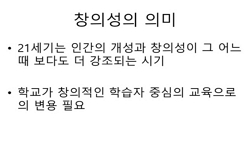The purpose of this study was to investigate the relationship between childrns's creativity and sex-role stereotypes at age 6. The subjects for tis study were 155 six-yeare-old boys and girls selteted from two kindergartens in Seoul. Children were te...
http://chineseinput.net/에서 pinyin(병음)방식으로 중국어를 변환할 수 있습니다.
변환된 중국어를 복사하여 사용하시면 됩니다.
- 中文 을 입력하시려면 zhongwen을 입력하시고 space를누르시면됩니다.
- 北京 을 입력하시려면 beijing을 입력하시고 space를 누르시면 됩니다.
6세 아동의 성역할 고정관념과 창의성과의 관계 = Relationships between Children's Creativity and Sex-role Stereotypes at Age Six
한글로보기https://www.riss.kr/link?id=A75004056
- 저자
- 발행기관
- 학술지명
- 권호사항
-
발행연도
1997
-
작성언어
Korean
-
주제어
창의성 ; 성역할 ; Sex-role ; Creativity
-
KDC
375.000
-
자료형태
학술저널
-
수록면
91-103(13쪽)
- 제공처
-
0
상세조회 -
0
다운로드
부가정보
다국어 초록 (Multilingual Abstract)
The subjects for tis study were 155 six-yeare-old boys and girls selteted from two kindergartens in Seoul. Children were tested in groups, with Torrance test of Creative Thinking-Figural A, and individully with the Sex Stereotype Measure(williams, Bennet, & Best, 1975). The data were analyzed aby frequency,percentile,mean,standard deviation,t-test, one way ANOVA,and correlations.
The major findings were as follows:
First, there was a statically significant difference in children' sex-role stereotypes by sex. But no statically signficant difference in children' sex-role stereotypes by birth order was found.
Second, there were statically significant differences in the sub domains of creativity and total creativity score by birth order.
Finally, The sex-role sterotypes were statically significantly related to children's creativity-fluencey, originality, abstractiveness of titles, elaboration, resistance of closure, and total creativity score.
The purpose of this study was to investigate the relationship between childrns's creativity and sex-role stereotypes at age 6.
The subjects for tis study were 155 six-yeare-old boys and girls selteted from two kindergartens in Seoul. Children were tested in groups, with Torrance test of Creative Thinking-Figural A, and individully with the Sex Stereotype Measure(williams, Bennet, & Best, 1975). The data were analyzed aby frequency,percentile,mean,standard deviation,t-test, one way ANOVA,and correlations.
The major findings were as follows:
First, there was a statically significant difference in children' sex-role stereotypes by sex. But no statically signficant difference in children' sex-role stereotypes by birth order was found.
Second, there were statically significant differences in the sub domains of creativity and total creativity score by birth order.
Finally, The sex-role sterotypes were statically significantly related to children's creativity-fluencey, originality, abstractiveness of titles, elaboration, resistance of closure, and total creativity score.
목차 (Table of Contents)
- 목차
- Abstract = 91
- 서론 = 92
- 1. 연구의 의의 및 목적 = 92
- 2. 연구문제 = 92
- 목차
- Abstract = 91
- 서론 = 92
- 1. 연구의 의의 및 목적 = 92
- 2. 연구문제 = 92
- 이론적 배경 = 93
- 1. 창의성 = 93
- 2. 성역할 고정관념의 개념과 발달 = 94
- 3. 창의성과 성역할고정관념간의 관계 = 95
- 연구방법 = 96
- 1. 연구대상 = 96
- 2. 측정도구 = 96
- 3. 연구절차 = 97
- 4. 자료분석 = 98
- 결과 및 논의 = 98
- 1. 아동의 성별 및 출생순위에 따른 성역할 고정관념 = 98
- 2. 아동의 성별 및 출생순위에 따른 창의성 = 98
- 3. 아동의 성역할 고정관념과 창의성간의 관계 = 100
- 결론 및 제언 = 101
동일학술지(권/호) 다른 논문
-
Cable-TV 패션쇼 광고에 대한 소비자 감정반응과 태도
- 경희대학교 생활과학연구소
- 양진옥
- 1997
-
합성 직물의 강신도와 Seam Puckering에 대한 연구
- 경희대학교 생활과학연구소
- 안찬희
- 1997
-
- 경희대학교 생활과학연구소
- 김경희
- 1997
-
- 경희대학교 생활과학연구소
- 남윤자
- 1997




 RISS
RISS






